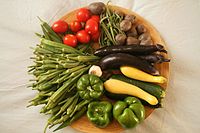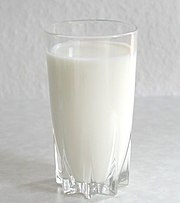Healthy eating habits/Healthy Eating for Pregnancy

This page provides education material on healthy eating for pregnant women between the ages of 18 and 50 years old.
During pregnancy it is essential to meet the nutrient requirements for health for you and your baby. The food choices you make during pregnancy directly affect the well being of your baby. The Australian Dietary Guidelines provide advice on what to eat for health and wellbeing and these recommendations are listed below.
Which foods should I eat and how much?
[edit | edit source]To meet the needs for you and your baby, you need to eat from the five food groups shown in Table 1 below.
Table 1. Number of serves needed from each food group during pregnancy.
| Food Group | Number of Serves |
|---|---|
| Vegetables & Legumes/beans | 5 |
| Fruit | 2 |
| Grains (cereal) foods | 8.5 |
| Lean meats, poultry, fish, eggs, tofu, nuts & seeds, legumes/beans | 3.5 |
| Milk, yoghurt, cheese & alternatives | 2.5 |
What is a serve?
[edit | edit source]
Vegetables & legumes/beans
[edit | edit source]- 1/2 cup cooked green or orange vegetables (for example, broccoli, spinach, carrots or pumpkin)
- ½ cup cooked, dried or canned beans, peas or lentils
- 1 cup green leafy or raw salad vegetables
- 1/2 cup sweet corn
- 1/2 medium potato or other starchy vegetables (sweet potato, taro or cassava)
- 1 medium tomato

Fruit
[edit | edit source]- 1 medium apple, banana, orange or pear
- 2 small apricots, kiwi fruits or plums
- 1 cup diced or canned fruit (with no added sugar)
Or occasionally:
- 125ml (1/2 cup) fruit juice (with no added sugar)
- 30g dried fruit (for example, 4 dried apricot halves, 1.5 tablespoons of sultanas)

Grain (cereal) foods
[edit | edit source]- 1 slice (40g) bread
- 1/2 medium (40g) roll or flat bread
- 1/2 cup (75–120g) cooked rice, pasta, noodles, barley, buckwheat, semolina, polenta, bulgur or quinoa
- 1/2 cup (120g) cooked porridge
- 2/3 cup (30g) wheat cereal flakes
- 1/4 cup (30g) muesli
- 3 (35g) crispbreads
- 1 (60g) crumpet
- 1 small (35g) English muffin or scone

Lean meats & poultry, fish, eggs, tofu, nuts & seeds, legumes/beans
[edit | edit source]- 65g cooked lean meats such as beef, lamb, veal, pork, goat or kangaroo (about 90–100g raw)*
- 80g cooked lean poultry such as chicken or turkey (100g raw)
- 100g cooked fish fillet (about 115g raw weight) or one small can of fish
- 2 large (120g) eggs
- 1 cup (150g) cooked or canned legumes/beans such as lentils, chick peas or split peas (preferably with no added salt)
- 170g tofu
- 30g nuts, seeds, peanut or almond butter or tahini or other nut or seed paste (no added salt)

Milk, yoghurt, cheese &/or alternatives
[edit | edit source]- 1 cup (250ml) fresh, UHT long life, reconstituted powdered milk or buttermilk
- 1/2 cup (120ml) evaporated milk
- 2 slices (40g) or 4 x 3 x 2cm cube (40g) of hard cheese, such as cheddar
- 3/4 cup (200g) yoghurt
- 1 cup (250ml) soy, rice or other cereal drink with at least 100mg of added calcium per 100ml
Fluid
[edit | edit source]- ~ 9 cups of fluid per day (1 cup= 250ml/ 2-2.5L per day)
- Mainly water, diluted fruit juice, and other unsweetened beverages
What are my energy requirements during pregnancy?
[edit | edit source]During pregnancy you need more energy and more nutrients. To meet these extra needs it is important to eat from the five food groups mentioned above. Energy requirements differ at different stages of your pregnancy. During the 1st trimester minimal extra energy and therefore extra food is needed. During the second trimester an extra 1.4MJ/day (330 Calories) is needed. During the third trimester an extra 1.9MJ/day (450 Calories) is needed. These extra needs should be met from eating from the five food groups, specifically the lean meats and the grains groups as you have increased requirements of these groups during pregnancy. A good way to keep track of kilojoules (Calories) is by using the app EASY DIET DIARY by simply entering in the foods eaten or even searching for foods prior to eating them.
Eating for two?
[edit | edit source]As you have extra nutrient needs for you and your baby, it is important to eat healthily during pregnancy. However it is important not to over eat and also minimise foods that are high in sugar, fat and salt.
How much weight should I gain?
[edit | edit source]It is important that you gain weight during pregnancy to ensure proper growth of your baby. The amount of weight gain recommended depends on your pre-pregnancy weight. Table 2 below shows recommendations on weight gain.
Table 2. Appropriate weight gain during pregnancy.
| Pre-pregnancy weight status (BMI) | Recommended weight gain |
|---|---|
| Underweight (<18.5kg/m2) | 12.7-18.2kg |
| Normal weight (18.5-24.9kg/m2) | 11.4-15.9kg |
| Overweight (25-29.9kg/m2) | 6.8-11.4kg |
| Obese (20kg/m2 or higher) | 5.0-9.1kg |
| Twin pregnancy | 11.4-24.5kg |
Source: Brown, J.E et al. (2011)
TIPS
[edit | edit source]- When increasing food intake, choose initially from the grains and the lean meats group as these foods provide the extra nutrients needed during pregnancy.
- Weight gain is important during pregnancy however too much weight gain should be avoided.
- Limit high fat/high sugar foods and enjoy a variety of foods from the five food groups.
- Plan ahead to save time for meal preparation.
Where can I find more information?
[edit | edit source]About Pregnancy: [1]
The Australian Dietary Guidelines can be found here: [2]
Easy Diet Diary found here: [3]
Cooking tips for busy people: [4]
For tips on food safety and specific nutrient requirements: [5]
References
[edit | edit source]Australian National Health and Medical Research Council and the New Zealand Ministry of Health. (2013). Australian dietary guidelines. Retrieved from [6]
Brown, J. E., Isaacs, J.S., Krinke, U.B., Lechtenberg, E., Murtaugh, M.A., & Sharbaugh, C., et al. (2011). Nutrition Through the Life Cycle (4th ed). Belmont, CA: Wadsworth, CENGAGE Learning.